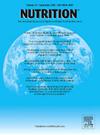外周脂肪酸与辅助生殖的结果
IF 3.2
3区 医学
Q2 NUTRITION & DIETETICS
引用次数: 0
摘要
本研究调查了接受体外受精的女性全血中脂肪酸水平与四种连续辅助生殖技术(ART)结果之间的关系。结果238名接受体外受精的女性参与了一项关于生活习惯和饮食对ART结果影响的研究。通过气相色谱法测量了血液中的多不饱和脂肪酸。总体而言,血液中单不饱和脂肪酸和油酸含量越高,ω-6/ω-3 比率和花生四烯酸/二十二碳六烯酸比率越高,抗逆转录病毒疗法的效果越好。相比之下,较高浓度的长链多不饱和脂肪酸往往与所考虑的结果呈负相关。结论需要进一步开展前瞻性研究,以确定不孕症妇女的最佳脂肪酸浓度范围。本文章由计算机程序翻译,如有差异,请以英文原文为准。
Peripheral fatty acids and outcome of assisted reproduction
Objectives
The present study investigated the relationship between fatty acid levels in whole blood in women undergoing in vitro fertilization and four successive assisted reproductive technology (ART) outcomes.
Methods
A cross-sectional study was performed on data from a prospective cohort study conducted between 2014 and 2016.
Results
Participants were 238 women undergoing in vitro fertilization and participating in a study on the role of lifestyle habits and diet in ART outcomes. Blood polyunsaturated fatty acids were measured by gas chromatography. Overall, higher blood levels of monounsaturated fatty acids and oleic acid and higher ω-6/ω-3 ratio and arachidonic/docosahexaenoic acid ratio were associated with more favorable ART outcomes. By contrast, higher concentrations of long chain polyunsaturated fatty acids tended to be negatively associated with the considered outcomes.
Conclusions
Further prospective studies are needed to determine the ranges of fatty acid concentrations that are optimal for women with subfertility.
求助全文
通过发布文献求助,成功后即可免费获取论文全文。
去求助
来源期刊

Nutrition
医学-营养学
CiteScore
7.80
自引率
2.30%
发文量
300
审稿时长
60 days
期刊介绍:
Nutrition has an open access mirror journal Nutrition: X, sharing the same aims and scope, editorial team, submission system and rigorous peer review.
Founded by Michael M. Meguid in the early 1980''s, Nutrition presents advances in nutrition research and science, informs its readers on new and advancing technologies and data in clinical nutrition practice, encourages the application of outcomes research and meta-analyses to problems in patient-related nutrition; and seeks to help clarify and set the research, policy and practice agenda for nutrition science to enhance human well-being in the years ahead.
 求助内容:
求助内容: 应助结果提醒方式:
应助结果提醒方式:


